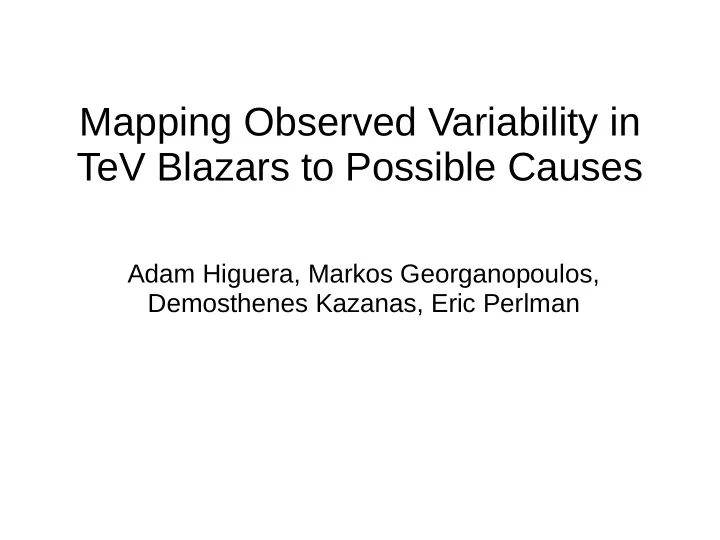

Mapping Observed Variability in TeV Blazars to Possible Causes Adam Higuera, Markos Georganopoulos, Demosthenes Kazanas, Eric Perlman
TeV Blazars Introduction ● Radio-loud active galactic nucleus with a relativistic jet pointed directly towards the Earth. ● Very broadband emitter – all the way from Radio to TeV Gamma Rays ● Spectra dominated by continua, not lines ● Non-thermal emission – continua are fat-tailed
TeV Blazars Introduction (cont) ● Radiation Produced by High Energy Electrons ● Critical energy of synchrotron radiation in units of rest mass energy given by: ϵ s = B 2 γ B crit ● Radiated power in units of rest mass energy given by: γ= 4 σ T 2 U B P s = ˙ 3 mc γ ● Also: synchrotron-self-compton (SSC) in Thompson Regime P SSC = 4 σ T 2 ϵ SSC =ϵ synch γ 2 U synch 3 mc γ
Quadratic Variations In the case of increasing electron injection, synchrotron responds linearly, SSC responds quadratically. P s ∝ n (γ) U B 2 U B P SSC ∝ n (γ) U s ∝ n (γ)
Nature Is Not So Simple ● On the slides that follow, we present some variability events in TeV blazars exhibiting some characteristics that cannot be explained by simply increasing the rate at which electrons are injected.
PKS 2155-304 Foschini et al. 2007
MKN 421 Fossati 2000
Nature Is Not So Simple ● Not only is variability not always quadratic, but peaks and edges move to different frequencies and change slope.
Our Model ● Two zones – acceleration and radiation. ● Electrons in acceleration zone accelerate with rate − 1 (τ ' acc ) and escape into the radiation zone with rate . − 1 (τ ' esc ) ● Electrons in radiation zone cool by radiation and are not − 1 accelerated, escaping with rate . (τ esc ) ● No photons from acceleration zone ● Photons and magnetic field from radiation zone cool acceleration zone ● We consider steady-state electron and radiation distributions
Our Model (cont) ● A population of electrons subject to no external forces and escaping with time constant tau obeys ∂ n γ n )+ 1 ∂ t + ∂ ∂ γ ( ˙ τ esc n = Q (γ) ● Electrons accelerated by magnetic shock gain energy proportional to their own energy with some characteristic time ∂ n γ− γ ) n )+ 1 ∂ t + ∂ ∂ γ (( ˙ n = Q (γ) τ ' acc τ ' esc ● Two characteristic energies ● - Balance acceleration and cooling − 1 γ max ∝(( U B + U p )τ ' acc ) - Balance between escape and cooling − 1 γ break ∝(( U B + U p )τ esc )
More Consequences (slightly less simple) ● Increases in the size of the electron distribution produce more photons. If photon field E. density comparable to magnetic, should decrease maximum electron energy and gamma break. In particular, − 1 γ max ∝( U total ) ● Increases in the magnetic field energy density should decrease the maximum electron energy and should shift high-energy spectrum components redwards. ● Increases in acceleration rate should increase maximum − 1 electron energy. In particular, γ max ∝(τ ' acc ) ● Increases in acceleration rate should harden spectrum in high energy region. In particular, p ≈ 1 + τ ' acc τ ' esc
Case 1: Fix Maximum Electron Energy Notice peaks shift redwards at high compton dominance – not observed. Peaks stay at same frequency at low compton dominance – observed, quadratic works.
Case 2: Allow Feedback Cooling Notice high-energy component varies more strongly than low-energy as before, but maximum energy and other spectrum features shift redwards due to feedback – also not observed. Evidence Against Electron-Injection-Only Flares
Case 3: Vary Electron Injection & B Field in Equipartition Redwards shift even more pronounced – not observed.
Case 5: Increase Acceleration Rate, Hold Spectral Index Constant p ≈ 1 + τ ' acc τ ' esc Maximum energy increases, spectrum features move bluewards, compton dominance increases slightly – in qualitative agreement with observation.
Case 6: Increase Acceleration Rate p ≈ 1 + τ ' acc τ ' esc Maximum energy increases, spectrum features move bluewards, spectrum hardens, compton dominance increases slightly.
Case 7: Increase Acceleration Rate, High Minimum Electron Energy Low Energy Tails unaffected by hardening of spectrum.
1ES 1959+650 Krawczynski et al. 2004
Abdo et al. 2011
3C 354.3 Abdo et al. 2009
Case 4: Vary Magnetic Field Note strong redwards shift, and decrease in compton dominance. On blue curve, second-order SSC no longer suppressed by Klein-Nishina – also not observed.
• Start with the observational situation, give a couple of plots. • So far, theory: electron injection flares -> quadratic behavior, why • 1. Even in this context there is place for superquadratic (show a plot) • 2. Model description and kinetic equation, equation for tacc from kirk. • 3. Even for gmax fixed, gbreak decreases. plot. • 4. now let gmax change, because tacc is fixed. plot. • 5. Let injection constant and vary tacc. plot. • 6. Conclusion: do not expect quadratic variations only. • ..... Check the same for equipartition flares and rule them out.
Recommend
More recommend